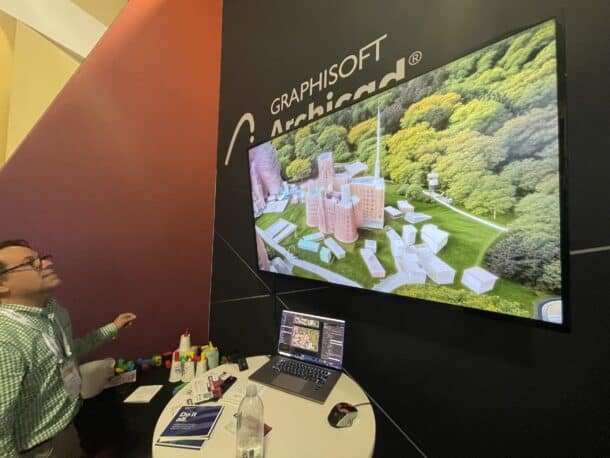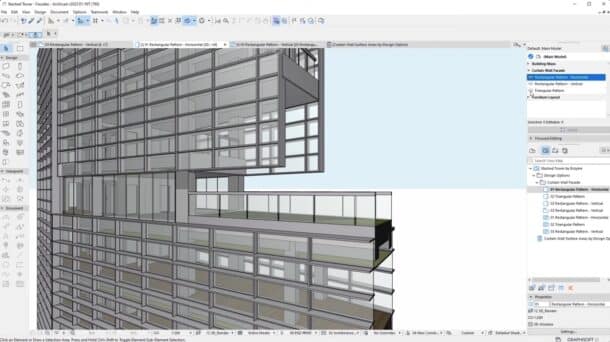We continue our coverage of what we saw at the 2024 AIA National Convention in Washington, DC. This report focuses on the remaining Nemetschek Group booth, while Part 3 will address Autodesk and Trimble. Part 4 will be entirely focused on Chaos Enscape, and finally, Part 5 covers Snaptrude, SketchPro.AI, Dell, and a few other tech companies at AIA.
Nemetschek Group Continued
Graphisoft had the largest area inside the giant 70-foot-long Nemetschek booth. At one point during a talk inside the booth, I referred to the Nemetschek booth as an “armada.” The Nemetschek Group booth was certainly a visually and spatially overwhelming show of force, with solid attendance from what we saw during our time inside and around the booth.
Generally speaking, Graphisoft’s Archicad tends to be a big tech destination for AIA attendees, and the Graphsoft team had distributed demo areas for Archicad, BIMx, BIMcloud, and AI Visualizer—along with its fun interactive physical blocks zone with a video camera live-streaming a view on physical blocks and cups (yes, the kind of you drink out of) which attendees were encouraged to play around with and build something.

Graphisoft’s interactive “physical blocks to computer vision to AI visualization” area was fun to engage in. What you see as a castle-like building with a brick red facade is AI generated from the upside-down cups and blocks assembled on the table in the corner.
Once you did that (and while you were playing blocks), an Apple MacBook was running some new experimental AI software that merged computer vision and AI with visualization to craft rendered scenes nearly in real-time. The experience was interesting and provoking because architects used to create physical models much more often than they do now. What’s interesting about the physical models of the AI rendering process is how iterative and fast it could be. Could this experimental technology be rolled up into an AI Modeling Visualization Kit? A kit that came with an array of different-sized modular blocks and an iPhone app that worked your smartphone’s camera and fed into the AI software? It’s an interesting idea because certain faces of blocks could be “coded” by their color to communicate to the AI that they are solid wall materials or glass, for instance, or the coding could be fully programmatic and left up to the user to determine. That’s the kind of experimental tech kit I’d love to get my hands on.
The Graphisoft folks had more than one interactive kit. The team also had the Apple Vision Pro headset and were showing attendees how the award-winning BIMx software works inside Apple’s ground-breaking immersive headset. (we awarded BIMx with Vision Pro and BEST of SHOW award honor this year). (see: Architosh, “Architosh 10th ‘BEST of SHOW’ honors for digital technologies at AIA National Washington DC,” 14 June 2024)

BIMx is Graphisoft’s award-winning technology that first began on mobile devices. It is the BIM industry’s first app on the Apple Vision Pro, and its implementation and UX are compelling.
BIMx is the first BIM technology to end up inside Apple’s groundbreaking (but expensive!) Apple Vision Pro headset. Those who have tried out the Apple Vision Pro say the device is in a league of its own as a visual and interactive experience. Graphisoft BIMx on Vision Pro enables the user to fully interact with the BIMx application using just their bare hands while wearing the Vision Pro. As we noted in our recent review of Archicad 27 this year, BIMx now features BCF issues capabilities. But with Vision Pro interrogating building design issues in an immersive 1:1 ratio virtual environment gives a user the superpower of being in the planned building before the building exists.
MORE: Product Review: Archicad 27 with BIMx and BIMcloud
BIMx also gained new, accurate sun positioning to demonstrate real natural light in building designs. Shadow studies are now accurate, and users can use sliders to change the date and time of day. The shadow intensity is also adjustable.
As for Archicad 27, AIA attendees watched at the booth to see how the true original BIM solution functions compared to the competition. This year, Archicad 27 introduced Design Options, which we reviewed here back in March. Their new Distance Guides technology is also a highlight feature that veteran Archicad users are delighted to have. There was also an experimental physically based rendering technology in Archicad 3D views, but we didn’t get to see it at AIA24.

Integrated Design Options is a major new feature in Archicad 27. This image is from our recent review.
Finally, Archicad implemented the new AI Visualizer technology first in its BIM solution, and before that, technology arrived in both ALLPLAN and Vectorworks; built to tap the power of Stable Diffusion, users can quickly generate compelling renderings from Archicad massing models in 3D. By combining a massing model with text prompt instructions, AI Visualizer speeds up design iteration and can produce visuals for clients and stakeholders, shortcutting workflows that have traditionally taken weeks.
dTwin
Nemetschek dTwin was also on display inside the Nemetschek Group super booth! dTwin is a major push by the Nemetschek Group to enter the “digital twins” market. Consistent with the Group’s Open BIM philosophies, dTwin is marketed as the AEC/O industry’s “first horizontal and open digital twin platform.”
In other words, Nemetschek’s digital twin strategy is to work with everyone or as many AEC/O vendors as possible for data input and roundtrip synchronization. Digital twins can begin with data integrations with AEC/O design applications, where BIM data is pushed to digital twin systems. This gets combined with reality capture devices during and after construction to synthesize data from multiple sources that speak to building systems often hidden from view while inside buildings (eg: in walls or above ceilings).
Connecting IoT sensors across building rooms, zones, systems, and equipment enables intelligence to be captured and monitored via dashboards and reports. dTwin can bring together CAD/BIM/IWMS and more forms of data with IoT sensor-based real-time streams of operations and merge them into intelligent dashboards. To learn more visit here.


